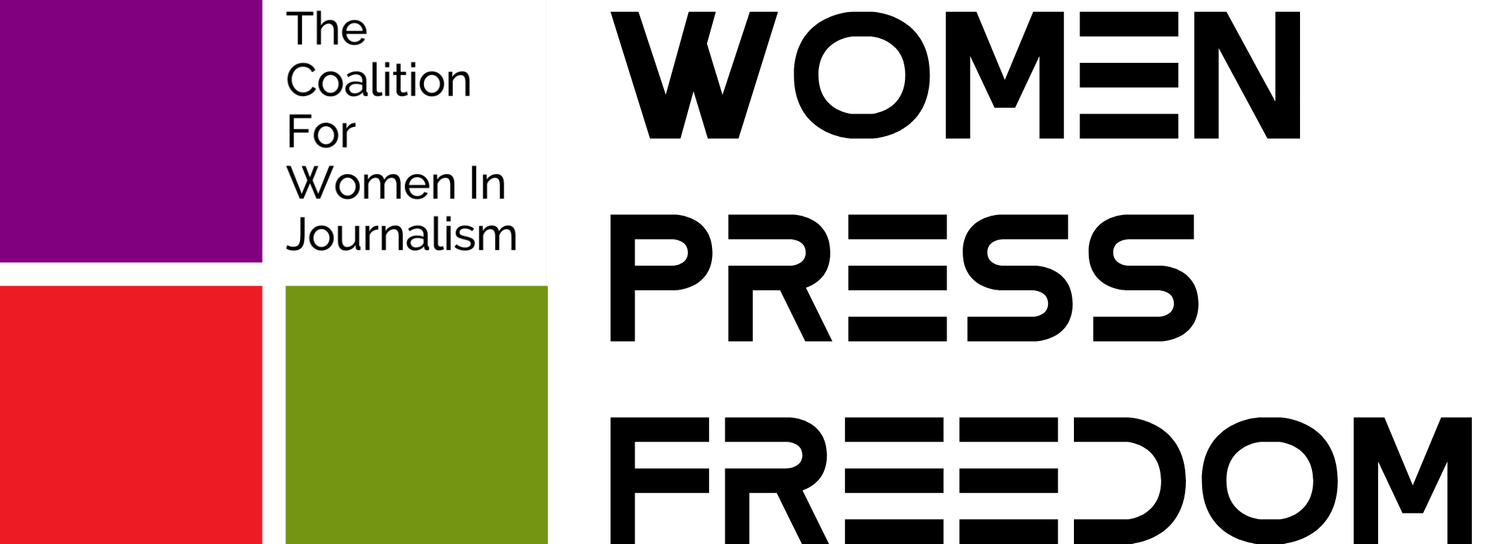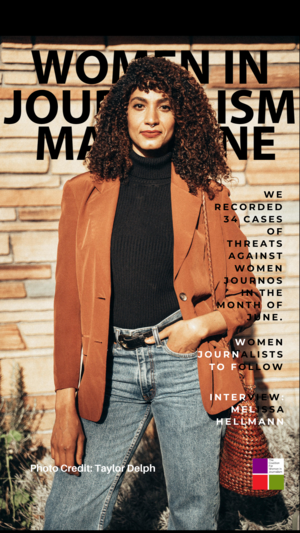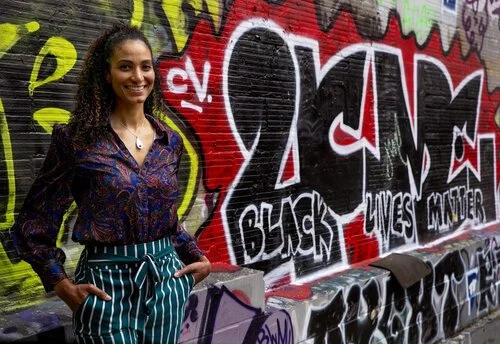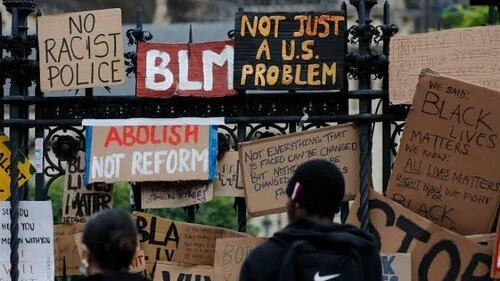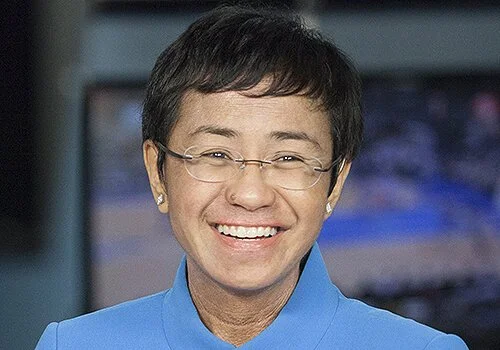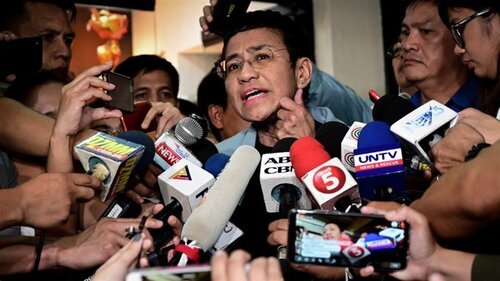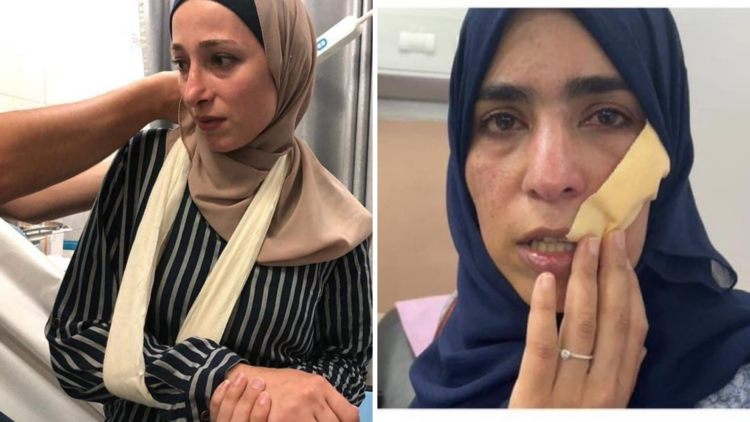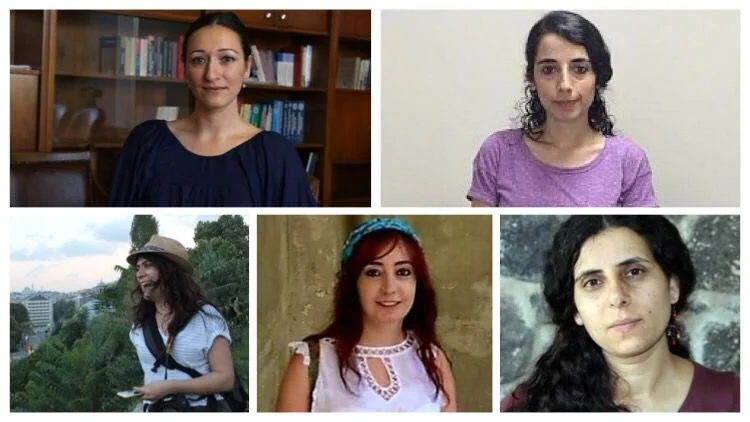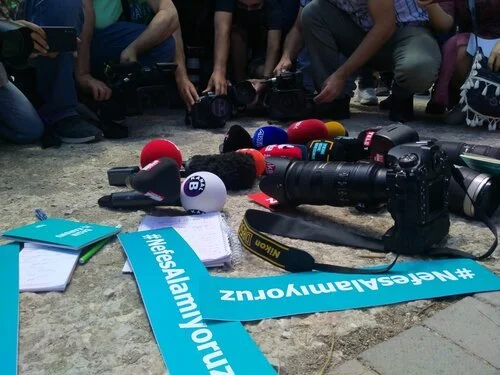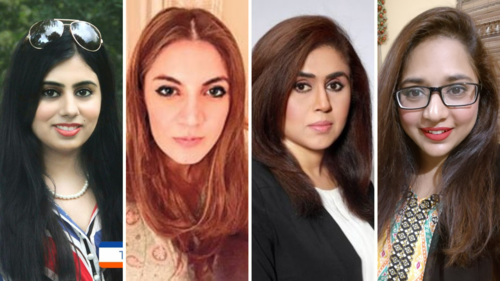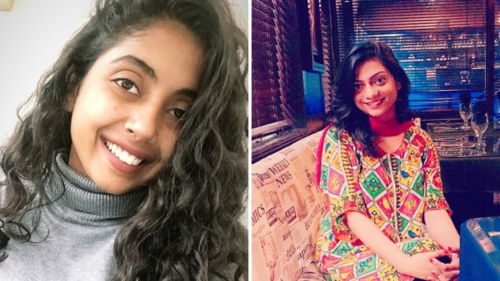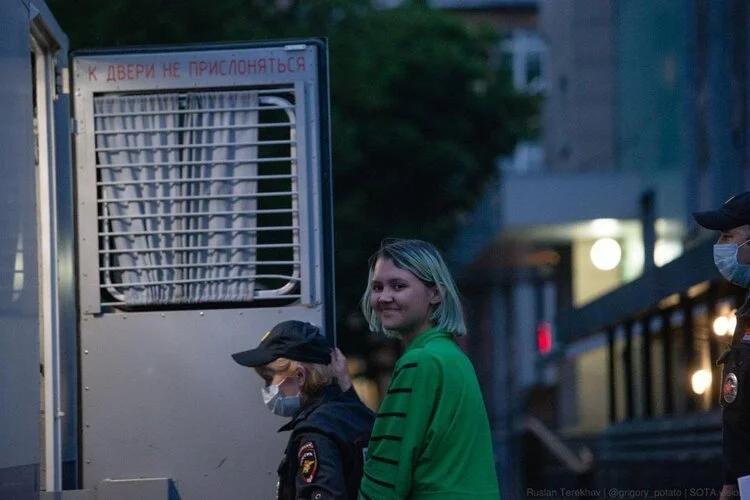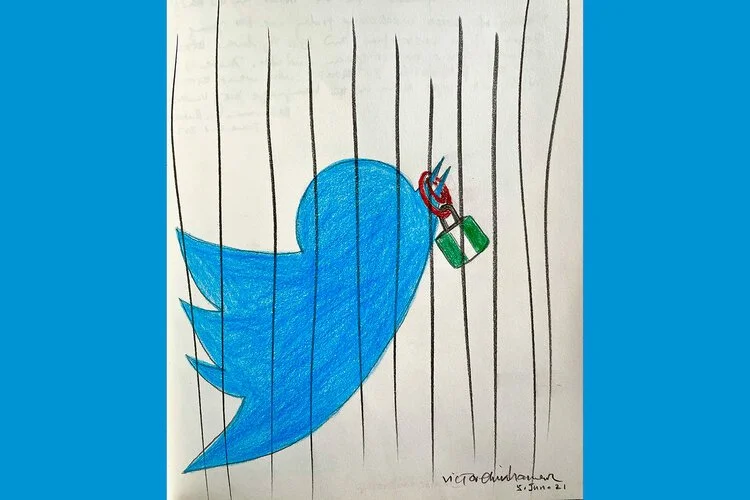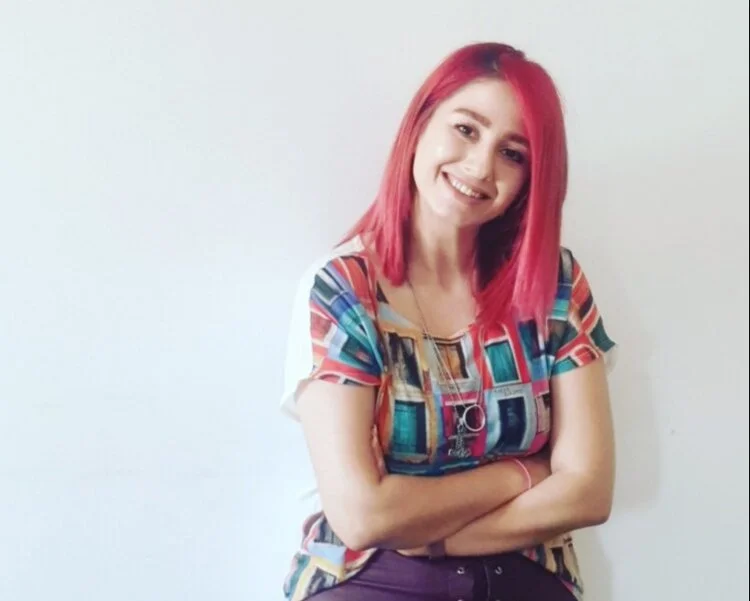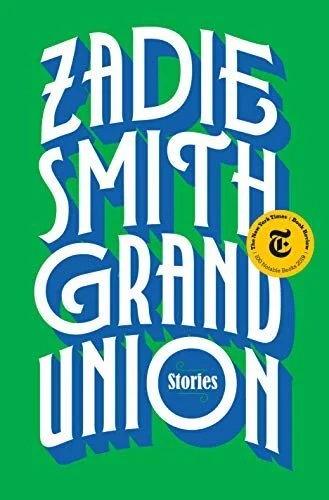May/June 2020 Issue
In this issue, we interview award-winning journalist Melissa Hellmann, focus on the Black Lives Matter protests happening in the U.S., analyze Maria Ressa’s case in a special report, feature badass Black women journalists who are covering the protests on the frontline. Go read.
Editor’s Note
Hello readers,
Hope you are getting some air this summer?
We are back with a joint issue for May and June, both months have been extremely busy with overlapping issues we have been following, covering and being actively involved in. As you things around us all have changed, we know you have been going through some sort of transition too; and given the amount of information flow around Covid-19 and the ongoing #BLM protests we know you have been dealing with, we decided to give our magazine a break.
In this issue of our Monthly, we focus on women journalists on the frontlines of the #BLM protests sparked in the United States and spilled over around the world. Our day to day work also revolves around safety of women journalists working on the ground, and that being an essential reality for women journalists on the ground, we have snippets for you.
We will continue to publish more on the issue of the ongoing movement of #BLM. In this particular issue we wanted to specially feature and emphasize on Black women journalists.
Somewhere along the way while we were following protests in the US as part of our support work for women journalists on the ground (find our page focused on US Protests here), we decided to launch a map that could show women reporters covering the issue. We shared this map with our network of editors and newsrooms. This map has been extremely useful for some newsrooms to work and assign more work to female freelancers. Feel free to go to our map here, find a woman journalist reporting from a location you're interested in and share their work.
While working on this we also realised that Black women were a) fewer in proportion and yet b) more often targeted in the field.
We hence created a Black Women Journalist List covering race and BLM in America; this list is easily distributable in newsrooms and we would urge you to follow these by-lines.
Feel free to view this gorgeous list here. Feel free to get in touch with a suggestion or offer of support. Learn more about how women journalists are targeted while covering BLM, here.
Our woman on the cover this month is Melissa Hellmann, an award-winning Seattle Times reporter, covering the #BLM protests in South King County, Seattle. Melissa talks to CFWIJ about reporting the demonstrations and the changes she sees in Seattle's local dynamics post-demonstrations as well as what it is like to work as a journalist of color in the US.
Zeynep Gürcan, our colleague in Turkey, wrote an opinion piece in honor of pride month. She shed light on how individuals from the LGBTI+ community need to be treated as more than just interview subjects and the need to have more LGBTI+ reporters.
Zeynep also interviewed Phillip Meylan from The Factual, who talks about how his team fact-checked women journalists and what credibility looked like for female by-lines on the beat. We found this work quite insightful.
Our researcher and write Rabia Mushtaq did a special report on Maria Ressa and the state of press freedom in the Philippines. An issue we are aggressively following and campaigning for. Our dedicated page on Maria Ressa's case can be found here. We also joined a 60 organization coalition called #HoldTheLine to campaign against the censorship under President Dutarte's regime. You can support Maria and press freedom by signing this petition.
In the rest of the magazine we maintain some of the regular sections: In our 'Women Journalists To Follow' section we feature four Black journalists. CFWIJ has also picked some podcasts by journalists of color which focus on racial justice, policing in the US, movements by the black community and much more to help you understand the current issues better from the very essential Black perspective.
Do write to us with feedback, love and support.
Happy Reading!
Kiran Nazish, Executive Editor
Rabia Mushtaq, Editor and Writer
Damla Tarhan, Design
Zeynep Gurcan, Contributions
With special thanks to Sulome Anderson
Melissa Hellmann - On Covering The #BLM Protests, Pursuing Transparency And Working As A Journalist Of Color In The Us
Melissa Hellmann is an award-winning journalist with 10 years of experience reporting across the world. Her work has appeared in several publications including the YES! Magazine, The Associated Press, and TIME among others.
Melissa is currently working as the Seattle Times’ South King County reporter with beats ranging from politics, law, health, education, and social issues. Following the recent turn of events in the history of racial justice in the US, Melissa has been covering the Black Lives Matter demonstrations, which took place after the brutal murder of a 46-year-old black man - George Floyd - by a white police officer in Minneapolis, Minnesota.
She began her reporting as the protestors took to the streets in South Seattle to fight for racial justice. While covering these protests on the ground her stories put forth the myriad aspects of this monumental event in the history of the black community. From stories highlighting the Junteenth events in the city to the plight of families who have lost their loved ones to police brutalities, Melissa has been taking note of everything under the sun in South Seattle.
Melissa also serves as the president of the Seattle Association of Black Journalists president and has taken up the whims to revolutionize the contributions of black journalists in the city.
CFWIJ spoke with Melissa to learn about her experience of covering the #BLM protests as a journalist of color and how she views the transformational dynamics of the events unfolding post-demonstrations. We also talked about the challenges she has faced in the journalism industry as a journalist of colour and the changes she wishes to see in the industry that actualize the ideas of diversity, inclusion and acceptance of all races within the profession. Read on.
PHOTO CREDIT: ERIKA SCHULTZ
PHOTO CREDIT: ERIKA SCHULTZ
Note: Our conversation with Melissa took place on June 22, 2020. Some of the events she discusses here may not be current at the time of this interview’s publication.
Q: What is the current state of the #BLM protests in Seattle?
The situation at CHOP (the Capitol Hill Occupied Protest) rapidly evolved during its several-week tenure. When the police abandoned the East Precinct, it grew into a space with community gardens, memorials for people killed by the police, teach-ins, a co-op with free food, and an encampment for houseless people. I live in walking distance to the area and regularly reported there; I mostly observed a peaceful protest during the day. Demonstrators often questioned the next steps in the movement and some criticized the space as a distraction from the fight for Black liberation. The police had shared unfounded rumors that the protesters were extorting businesses, which was later debunked. But there was some animosity among businesses about the protesters’ presence. In late June, businesses and residents filed a lawsuit against the city for abandoning CHOP and leaving the area unchecked by law enforcement. Following the lawsuit and a spate of gun violence in the area, the city dismantled CHOP last week. Collectives were born out of the occupied protest, and demonstrations have continued despite its absence.
Q: What are the local dynamics like in terms of the protests, following the closure of businesses (in solidarity with the protestors)?
In CHOP, there are still some buildings that are closed. Honestly, a lot of buildings have been closed for the past few months because of Covid-19. I don't know necessarily if these buildings have been closed because of the protests. There are some shops around CHOP that are still open, so I don't know if anything closed down because of the demonstrations, in particular.
Q: How would you describe the participation of the white community in protest taking place in Seattle?
Seattle is mostly a white city. It is almost 60 percent white I believe. A lot of the black community that was in the central district - the historically black area, have moved South because of the gentrification, so there's not a large black population in Seattle.
Most of the protests are led by people of color but many of the participants are white. They are mostly younger white people, so it's hard to say that white people as a monolith have had a certain opinion on this. I see a lot of young people who are galvanized by this and who believe that black lives matter and have been out there protesting. I have also been getting emails from older white readers who are very upset. They write that people of different colors have always lived together in harmony and this has not been an issue until now. So there are some people who are blind to their own biases and racism that has continued to persist over hundreds of years.
A few days ago, just a couple of people initiated what they called the Capitol Hill Blackout, so that was just one day where a section of the park, where Capitol Hill occupied protests took place, was just dedicated to black healing. They had an ancestor healing ceremony and a grieving event. It was just a really peaceful place where about 50 black people gathered. A lot of people were really upset about it and they said it was segregation. Meanwhile, it has been occupied by mostly white protestors for the past few weeks and I had not seen the same amount of vitriol that I heard that day.
Q: Is there an aspect of the protests that interested you in particular as a journalist reporting on the ground for Seattle Times? And why?
This was an all-team effort. I just started a new beat covering Seattle and South King County, and this is an area where there are a lot of people of color, as well as the immigrant communities. Also, it has not received much media coverage over the years, so I felt it was an important coverage area. But basically as soon as I started this, Covid-19 was underway and then the protests started, so I have mostly been covering the protests the past couple of weeks.
It was something that I felt moved to do because it is literally right outside my window. During the initial days, I wasn't covering it and saw thousands of people walk by outside. But just being at the epicenter for all these demonstrations, I felt like I was missing out by not contributing and not documenting history because it's my job. So I asked to become more involved in the past couple of weeks.
It has also been very empowering to watch it, especially as a mixed-race black person - I'm half black and half white. It was important for me to be able to engage in this, otherwise, it would just have been very depressing to watch it from the sidelines.
Q: As a journalist of color, what was it like for you to report on the brutalities against the black community and the protests that followed? What is challenging for you to stay neutral when covering the protests?
I take issue with the term neutrality and objectivity in journalism because it is a very coded term and is usually directed at people who belong to marginalized communities. The most important to me is transparency and accountability in reporting - that's something that I always pursue. It is something that I pursue when I'm talking with activists. I don't just take their word for it and (reach out to) at least a couple of other voices that can back it up. The same goes for the police as well - I don't just take their word for it.
That is where some reporters have gotten themselves in trouble in the past where they've just had maybe taken the police's word without realizing that they have their own vested interests in this as well.
Sometimes they don't tell the truth, so it is important to me that I fact check everyone whom I speak with. I'd say that I brought my own lens into it which enriched the stories that I have worked on. As far as neutrality is concerned, I'd say that I did my job by being transparent and accountable.
Q: Have you been to the autonomous zone? What is that like? And b) Given the history of Tulsa and Rosewood I am sure it brought back memories for many. Do you think things would have been different back then if there was an active media presence?
Yes, I live just a few blocks away from the Capitol Hill Occupied Protests, so I have covered it. I don’t know if there was a lot of media presence at Rosewood but there definitely was in Tulsa.
Actually, one of the inciting incidents for the massacre in Tulsa was a newspaper article that basically was a call to action for white residents to seek justice for what they believed was an attack on a white woman. But throughout history, especially during that time, journalism has been used to bolster white supremist agenda, so I don't have faith that the media would have done it diligently; that it would have done it justice and prevented those attacks or others after it from happening.
Now that technology is more pervasive and people have greater access to information, it has helped with our awareness. But still, there were so many reporters out there in Ferguson and there were still so many other shootings of black men after that, so it did not necessarily prevent it. It raised awareness and made more people angry.
But part of what has caused this civil unrest right now is partial because of Covid-19. A lot of people were feeling disheartened by the government in general and felt disenfranchised because of the systems that are in place. Also, having a lack of connection for so many months made people really want to seek that and to be part of something that was larger than themselves.
Seeing those seven minutes and 45 seconds of George Floyd being killed by the cop, who had his knee pressed on his neck, really galvanized people into taking action.
I do, obviously, see journalism having a purpose and moving these movements forward, but it has also contributed to biases. I hope that marginalized communities will be better represented in the newsroom and also in our coverage so that we are able to inform people in a way that pursues racial justice more.
Q: We have seen in our work with women journalists, particularly those of color, that they tend to face immense discrimination within newsrooms and in the field when doing their job. Have you experienced anything similar? How would you describe your own experience, given your work as a journalist for various news outlets, throughout your career?
Yes, it definitely has happened - with my sources and in newsrooms. It often is not very overt; it often happens on my microaggressions with a lot of coded terms. I have been told throughout my career that I don't have enough experience for a position, although I have a master’s degree from UC Berkeley in journalism and also have 10 years of journalism experience around the world. I have been told that as recently as a couple of years ago and this is something that I’m continuously told.
People believe that I am younger than I actually am or that I'm an intern. This was something I was asked when working for the AP in Kansas. I was working at the State House as a reporter at the Capitol Hill and when I would walk into senate rooms or go to hearings, politicians would sometimes ask me if I was an intern - they didn't believe that I was a reporter.
Something that I’ve also come up against was with sources, where they've been very disrespectful. I talked with someone a couple of years ago and as soon as I started asking my question, he immediately started cutting me off and told me to shut up for about a minute. When I called him out, he was very offended and later tried to get me fired from that job. He kept pestering my boss saying that I was a terrible reporter. Luckily, my boss stood up for me.
Things like that have happened before. I've had sources trying to hit on me and not taking me seriously. I've also had people try to pay less than the median wage for a newsroom. It is also something I've had to talk to the union representatives about before and try to figure out how much the rest of the newsroom is making, to ensure that I was making the same amount.
Q: You’ve been serving as the president of the Seattle Association of Black Journalists as well. How does the association support journalists, especially women journalists, within the community?
I have just been the president for about a year now. We actually restarted the chapter after it was dormant for two years, so we have had to start from the scratch as an organization. It has been slightly challenging but I have great board members - about 20 people - who come regularly, so there is obviously a lot of interest in this. Right now, we have been focusing on trying to restructure the chapter. We are going to work on our strategic statement that is going to guide us in how to create some new board roles and we've been involved in different communities by being affiliated with other organizations such as the Asian American Journalist Association. We put on a couple of events with them right before quarantine in early March.
The association also held a speed mentoring event where we had about 20 established journalists and 20 students, who were mentored for about six minutes each. We've also had happy hours for journalists of colour and had a holiday party back in early January where we had about 100 people. We sold tickets and donated most of that money to the Globalist, a local publication that hires journalists of color. It was struggling financially at the time, so it was important for us to ensure that they continued to have jobs, get paid and that their voice remained a part of the community.
Right now we're trying to focus on our own chapter and bolstering it, getting up our general funds, so that we can hold professional development opportunities for our members and do conferences. We have a lot of plans that we hope to accomplish in the future - holding more mentoring events, having opportunities for members to learn how to negotiate, how to become managers, and how to advocate for themselves in the newsrooms.
We’re pretty well represented within women and men in the chapter. We don't have anything specific that has been catered towards women. However, this is something I'm going to think about in the future to support women journalists or the LGBTQ+ community better.
Q: As a journalist of color what sort of changes would you like to see in the industry?
I would like to see more journalists of colour in the newsrooms. I would like newsrooms to take diversity and inclusion seriously. There has been this call to diversify newsrooms, but oftentimes it is not something that the newsrooms truly believe and what they are actively pursuing.
When they do hire journalists of color, they are often tokenized and are asked to just cover news based on whatever community they belong to. I would like newsrooms and media, in general, to not think of people of colour as a monolith. They should think of us as individuals. Each of us comes with our own lens and own background that only enriches stories, it doesn't take away from it or spin a certain agenda.
I would also like journalists of colour to get paid as much as our white counterparts and to not have to fight for it. I want that to just be something on the table as soon as we start negotiating.
I would also like newsrooms to take a chance on young journalists of colour, even if they don't have as much experience as they maybe would want for a position. Oftentimes, it's because of institutionalised racism that they haven't had the same opportunities as their white counterparts, so it is important for newsrooms to take that into consideration when they're hiring.
I would also like us to go out into marginalized communities more to gain their trust. I would like all journalists, not just those of color, to feel the need to represent the communities of colour, because a negative portrayal of black people - especially in the media - has contributed to this narrative of black people that has led to their killings. It is very important for us to think very carefully about how to cover race in America.
Q: What role do you think media giants can play in making this possible?
I think that they could come out with a strategic statement that prioritizes diversity and inclusion. They could also hire some consultants to help them with this, because oftentimes, journalists of color have the unpaid job of being diversity and inclusion experts. It is unfair because it takes away from our reporting. We should be paid for any advice that we give them. They can actively pursue that.
Media organizations can expand their coverage by creating new beats or roles that focus on race and marginalized communities, which really prioritise it and do not think of it as some niche beat. It needs to be front-centered and indifferent reporting - arts and culture, sports, crime coverage. There needs to be more inclusivity, because not highlighting race in these stories takes away the nuance of people's stories.
Large newsrooms can also prioritize having BIPOCS and other members of marginalized communities in leadership positions so they have a role in hiring, coverage, and the direction of the organization. It’s important that the makeup of newsrooms reflects our increasingly diverse nation.
Is The Press Really Free In The US?
How the ongoing civil unrest has finally exposed America's free press facade
By Rabia Mushtaq and Zeynep Gurcan
"I can't breathe." George Flyod - a black citizen of Minneapolis, Minnesota - uttered these three words moments before he was murdered by a white cop, who knelt on his neck in a bid to arrest him for allegedly using a counterfeit bill on May 25. It has been more than a month since Floyd's murder, but his words continue pierce through our hearts till date. Whenever and wherever one would witness injustice and oppression, Floyd's words would reverberate.
What happened after the brutal killing of a black man at the hands of a white cop has unfolded one of the most monumental events in black history. Black people across the US, as well as advocates of human rights and racial justice stepped out to condemn the atrocious structure of policing across the country that discriminates against citizens on the basis of the race.
During times when the world is up against a pandemic, all eyes were now also set on the events that continued to unfold in the US. It was the dedicated reporting of journalists on the ground that made it possible for people around the world to witness the widespread protests and unrest . However, the price paid by these reporters on the ground is something we often overlook as readers and as an audience.
As police across the US lined up against the protestors, journalists continued to do their jobs despite the risks of facing assaults and arrests in the process. Around 80% of reporters and photojournalists covering the protests on the ground have faced violence and intimidation at the hands of the law enforcement, raising questions about the state of press freedom in the US. Between May 26 and June 3, the US Press Freedom Tracker received more than 279 claims of assaults against press personnel on the ground.
Women journalists, too, made up a large part of the ratio and have borne the brunt of being caught in the middle of the disruption. The Coalition For Women In Journalism documented at least 28 cases, where women journalists were subjected to violence while covering these protests on the ground.
On May 29, Linda Tirado - a freelance journalist based in Minneapolis - was hit with foam bullets, while she moved in front of the protestors to photograph the police. Linda was left blinded in one eye with blood dripping all over her face. Despite yelling "I'm press" repeatedly, Linda's press credentials were ignored by the police. She later filed a suit against the state and city authorities.
Cerise Castle, a radio reporter for KCRW, was shot with rubber bullets by the LAPD. She was reporting while protestors gathered at Beverly and Fairfax in Los Angeles. Cerise also shared that she held a press badge above her head to identify herself as a journalist, but to no avail.
Photojournalist Beth Nakamura was also physically assaulted by police, as she was photographing the demonstrations in Portland, Oregon.
Five Thirty Eight's senior science reporter Maggie Koerth had a weapon pointed at her by the police in Minneapolis. Maggie was accompanied with another journalist when she was intimidated, and despite yelling "Press, press - we are press" continuously, the two had to hold their badges up and put their hands up in the air.
She shared her ordeal in a tweet that read:
"We just had MPD with support from outside sheriffs point weapons at us while we screamed that we were press. “Shut up!” one yelled back. We are safe."
These are few of the many occasions during the ongoing Black Lives Matter protests where women journalists were threatened with violence and assaulted while doing their jobs. The demonstrations exposed the so-called idea of press freedom that the US otherwise claims to value. This has also had an impact on the mental health of several women journalists who continue to feel vulnerable to the risks in the field.
On June 2, Canadian journalist Anna Slatz of Rebel News was arrested while covering the unrest in New York. She was physically assaulted by an officer of the NYPD and was detained for two days for "disorderly conduct".
When talking about the impact of the episode on her mental health, Anna said, "It made me very anxious... I had a very physical reaction to the sight of the NYPD. That carried over into the next night."
Anna said that she hit the streets for reporting the day after being released and it did not stop her from continuing to work.
"They wanted to scare me out of reporting and being on the street, when I had every right to do both. I felt that if I stayed away, I was letting them win... The best coping mechanism is listening to yourself. It is staying true to what you believe and doing what you think is right in all cases," she said when responding to CFWIJ.
On the other hand, Donna Bryson - a housing and hunger reporter at Denverite - was not quite sure if she could feel the impact at the moment, as the general emotions around the protests are currently running high. She told CFWIJ that it could take years before it becomes more clear, as her mental health currently does not feel affected.
Given the lack of safety, security, and reporting an event as significant as the #BLM protests, the Atlanta based freelance photojournalist Lynsey Weatherspoon spoke about her mental health and the way she has managed to keep herself grounded.
"The challenge of covering protests is the adrenaline and then the crash, and you have to recognize it when both hit. My dreams have been much more vivid than normal, and cause slight anxiety,” she said.
Lynsey also added that during her off days, she decompresses with meditation and takes care of her plants, along with listening to music.
“I'm recognizing that I will need to speak with my therapists soon, but my coping process has been healthy for me this far, she said.
Documentary filmmaker and photographer Brooke Herbert shared her concerns about the safety of journalists while covering the ongoing demonstrations.
"Journalists have been targeted during this movement and while I don't want to take the focus away from what the movement is about, it is also important to note the many ways journalists and photographers are being mistreated, targeted, and prevented from doing their work safely,” she said.
Brooke also spoke about the emotional turmoil of seeing so many people in pain.
“But it's also been a beautiful movement, with so many people joining together to fight injustice," she told CFWIJ.
If journalists - particularly women journalists - working on the frontlines continue to be subjected to violence for their reporting, it would not take long for them to rally for freedom of the press. It is pertinent that a country that prides itself in upholding human rights, must do more to ensure the safety and security of those who are only trying to inform the public as part of their job.
The fact that the US Constitution protects freedom of the press in the First Amendment, these attacks and arrests of journalists working on the ground - despite the risks to their safety and health, given the situation of Covid-19 in the country - makes for an apt example of what hypocrisy looks like.
Find more on our dedicated US Protests page.
Maria Ressa's Conviction And The State Of Press Freedom In The Philippines
By Rabia Mushtaq
On June 15, the Philippines witnessed an arbitrary attack on press freedom. Maria Ressa, the CEO of Rappler - an online news website, was convicted for cyber libel along with Reynaldo Santos, a former writer-researcher at Rappler. The two were released on bail pending appeal, but stand the risk of facing six to seven years in prison.
On June 29, their lawyers submitted a 132-page motion to appeal Maria and Reynaldo's conviction before a court in Manila, urging the decision's reconsideration by Judge Rainelda Estacio-Montesa. As stated in the motion, Judge Montesa committed at least 13 errors in her verdict.
"We have to acknowledge the real uses of criminal libel if we are to be consistent to protect speech made to make public officers and government accountable. Criminal libel has an in terrorem effect that is inconsistent with the contemporary protection of the primordial and necessary right of expression enshrined in our Constitution," the motion read.
As journalists and advocates of press freedom closely monitor the case, it is pertinent to understand why the Philippines - a country known for its vibrant democracy in the Southeast Asian region - is going through a press freedom turmoil under President Rodrigo Duterte's administration. What happened with Maria and Rappler began with a a typo - a fixed one, that is.
When speaking with CFWIJ about the current state of journalism in the Philippines, Lian Buan, a Rappler employee shared that the Philippines' government is now mimicking the restrictive ways of other authoritative countries in the region.
"The Philippines is supposed to have one of the more vibrant democracies within Southeast Asian or the Asian region at large. It feels like now we are trying to follow the footsteps of the more restrictive governments," she said.
Lian shared examples of Hong Kong, Singapore and Thailand, as all of the countries have been under immense criticism for their laws suppressing freedom of the press in the region. She added how the Philippines is now on its way to implement an anti-terror law, which will worsen freedom of speech and expression in the country.
What stops the government to charge and convict Maria and Reynoldo is that the anti-terror law has not yet been implemented.
The Philippines' government stretched the prescription period of libel from one to 12 years. For instance, if someone publishes a post or content online within the last 12 years, they are at a risk of being sued for.
Kath Cortez, a Filipino freelance journalist covering politics and governance, spoke with CFWIJ shedding light on how the possibility of the Anti-Terrorism Law makes it impossible for journalists to practice their profession without the fear of being ostracized.
"As a journalist who covers politics and governance as well as war and conflict, I must say that this administration abhors criticism and dissent of its own people. The current administration recently proposed the Anti-Terrorism Law as an effort to suppress the growing sentiment of the public due to poor government service, widespread killings under the umbrella of government’s War on Drugs including the propagation of false news and information," she said
Kath added that the law "practically cancels all the protection of rights of Filipinos including journalists guaranteed by the Bill of Rights. These will eventually kill the freedom of the press, the freedom of expression; consider journalist as a terrorist and our critical reportage as an act of terrorism."
The case against Maria and Reynoldo is also rooted in a 2012 investigative article - focused on justice Renato Corona's use of a vehicle registered under the name of businessman Wilfredo Ken, who is known for alleged connection to illegal activities - produced by the online news website on May 29, 2012.\
Even though the article was published two years before the country's cyber libel law came into effect, Rappler was taken to the court for the correction they made to the story, after Keng filed a cyber libel complaint in October 2017.
Keng claimed that "the article was published by Rappler without observing the ethical standards of journalism. It contained malicious imputations of crimes, with bad intentions, purposely to malign, dishonor and discredit my character and good reputation."
In February 2018, Maria and Reynaldo filed counter-affidavits to the complaint, which argued that "no cyber libel took place as the investigative report was published four months before the enactment of RA 10175. No criminal law is retroactive." They further argued that "online libel “is not a “new crime” and is the same as the old crime of libel in the 1930 Revised Penal Code (RPC). Article 90 of the RPC extinguishes criminal liability within one year."
Through the case, Rappler continued to be dragged in the mud using the law as a weapon. In February 2019, Maria was arrested on grounds of cyber libel and spent the night in the National Bureau of Investigation's (NBI) custody and posted bail before a court in Manila the next day.
Apart from being the head of Rappler, Maria is known for her courageous journalism and speaking truth to power. President Duterte and his supporters have always been very vocal about their dislike towards Maria, accusing her of disseminating fake news via Rappler.
As if this was not enough for an accusation, Duterte also claimed that the website was funded and owned by an entity in the United States - deeming it to be fulfilling agendas of the west in the Philippines. Rappler was, therefore, also investigated by the Philippine Securities and Exchange Commission (SEC) in August 2017, which led to the cancellation of its registration by January 2018.
However, the website fought back and appealed against the baseless allegations. It continues to operate following an under-appeal status of the decision till date. the website continued to use their platform to inform the public and committed to holding the powerful to account. They wrote, “We will hold the line.”
Advocates of press freedom around the world condemned the victimization that Maria and Rappler were being subjected to. However, Duterte's administration was adamant to suppress the website's critical reporting on the government, as Maria was, yet again, detained on arrival at Manila's international airport in March 2019. She was granted bail after paying P90,000.
When responding to the press after being rearrested in 2019, Maria said, "Obviously this is yet another abuse of my rights. I am being treated like a criminal when my only crime is to be an independent journalist."
The long trail of events challenged Maria and her news organization, but she continued to fight back. Maria won a separate libel case filed by John Castriciones, the Agrarian Reform Secretary, after his complaint was dismissed for lack of probable cause by the Quezon City prosecutor.
Sharing her views in the aftermath of Maria's conviction and the deteriorating state of press freedom in the Philippines, Marguerite Alcazaren de Leon - the opinion editor at Rappler, said that it is going to be a very steep uphill battle for everyone – Rappler, the Philippines, and basically any nation whose press freedom is under threat.
"Rappler, in particular, is facing the kind of government that will do everything it takes to subdue its critics, and it's really just a matter of just doing our jobs regardless of the threats and intimidation thrown our way. Granted, that's easier said than done, but this has always been a matter of will anyway," she said and added that it is even more distressing given that the country is in the middle of a pandemic.
The weaponization of law has instilled a sense of fear and has placed immense risk on journalists who are merely doing their jobs.
"There's a term experts and academics use: lawfare = law as warfare. The government's brazen legal acrobatics will make your head spin. Trumped-up charges, ridiculous loopholes, etc. They're making a mockery of our legal system and our Constitution, and that's very frightening," said Marguerite.
While Lian said that the threat (to freedom of speech) is veiled. "It is not an open threat and it is not a policy that is outrightly violating our freedom of speech guaranteed under the constitution.”
She added that the weaponization of law is very dangerous, as it does not directly impact those within the masses.
"It is very easy to weaponise the law because it is so foreign that even the more educated ones have a hard time understanding it. It is such an exclusive and elite discussion, which is only understood by a small group of people," she said and added that maybe that is the challenge journalists and civic leaders face - making the law understandable to people and explaining its repercussions following its weaponization.
Kath also expressed her concerns about Maria and Reynoldo's conviction following the usage of law to attack the press.
"I see the case of Maria and Reynoldo as a manifestation of how the people in position and the government, per se use its power to weaponize the law to, of course, stifle criticism and dissent. This reality does not spare journalists with critical reportage to become subject or target of intimidation to silence the media community and soon the entire citizenry once they decide to call out government abuse," she said.
Kath further added that the emphasis of this is the continuing "Culture of Impunity" in the Philippines from the effort to shut down a big network to never-ending threats and harassments of journalists even if in the middle of this Pandemic.
Rappler was not the only media outlet to have come under Duterte's ire. The country's biggest media network, ABS-CBN was also shut down for their critical reporting against the government.
According to Marguerite, the shutdown of ABS-CBN has "deprived many Filipinos living in remote areas of the crucial information they need at this time. It really goes to show that an attack on press freedom is an attack on all citizens too."
Looking at the broader Asian region, the state of press freedom is much worse than what it is like in the Philippines. Most countries across the region do not provide a viable climate for press freedom without being subjected to scrutiny.
Following her years of experience and expertise on freedom of speech and expression, CFWIJ reached out to Kirsten Han - a Singapore-based journalist and activist - to understand the struggles of journalists across Southeast Asia.
"Journalists in Southeast Asia often have to struggle against oppression and censorship on many levels, from self-censorship due to entrenched climates of fear, to pressure from co-opted editors, employers, or publishers, to direct repercussions or intimidation," she said.
While Marguerite deemed culture to be the reason why the Asian region lags behind in terms of press freedom.
"Many of us are raised to keep our more critical opinions to ourselves, to keep the status quo instead of shaking things up. That helps give way to the kind of government that can do things with impunity, including silencing the press whenever it displeases them," she said.
Marguerite added that the region has a history of strongman leadership. Apart from Duterte, Indonesia is governed by Suharto, and Malaysia by Mahathir Mohammad. While two Reuters journalists were jailed in Myanmar because of the military regime.
Kirsten shared her views on Maria's conviction, stating that she was not surprised but was immensely disappointed when she found out about the decision.
"I think the erosion of press freedom in the Philippines is really troubling, and unfortunately when the situation deteriorates in one country, it can embolden governments and/or powerful people in other places to also chip away at press freedom in their own contexts," she said.
Kirsten also added that not only in the Philippines, but journalists everywhere have to start worrying about cyber harassment and trolling, which not only wastes time and resources, but can also take a toll on their mental health and emotional well-being.
She said, "From observation, I've found this to only be even more intense when the journalist in question is a woman. It just adds yet another layer of trouble and worry on top of a job that can already be very stressful."
Given the repressive ways of the Duterte administration and the overall state of press freedom across the Asian region, journalists remain vulnerable to being victimized for their work. In such a situation, those aspiring to pursue journalism may end up questioning the profession. However, both Marguerite and Lian at Rappler believe that the fight to #HoldTheLine is not one to be lost.
"I believe international support is key. It's not only locals who should hold our government accountable, but the global community as well, because what happens in one country can certainly set a precedent for other countries. It's important that Rappler keeps doing its job in the face of everything that's been happening, but we also need the global community to recognize what we've been up against and help us shine the light on the injustices in our country," said Marguerite.
While Lian placed her hope in the younger generation of journalists, whom she stated will also stand up against the oppressors of press freedom, just like their seniors did in the past.
"Filipinos again have the chance of showing the world that if our freedom is threatened, we will fight back; we will push back. Maria's crisis presents us with an opportunity (to do so). We, especially the younger ones, are very hopeful that we can probably do it again with the help of the internet, which is now more powerful and we have a chance to use that to our advantage," she said.
The Coalition For Women In Journalism also supports and upholds the values Maria and Rappler have instilled within the sphere of journalism. Speaking truth to power and standing up against oppressors of press freedom should not apply to the Philippines only.
We believe that the press must not be restricted using the chains of law and strongly condemn the weaponization of legal tactics to threaten the many Maria and Reynoldo around the world. We, too, #HoldTheLine in solidarity.
Round Up Of Threats Women Journalists Faced
Turkey: CFWIJ demands justice for journalists Şehriban Abi, Nazan Sala and Zeynep Durgut, Journalism is not a crime
The second hearing of the trial against journalists Şehriban Abi, Nazan Sala and Zeynep Durgut was held.
Jul 2, 2021
Palestine: CFWIJ condemns the violent attack on women journalists by security forces
Several Palestinian women journalists were brutally targeted while covering the demonstrations held in Ramallah.
Jul 1, 2021
Turkey: Trial against five journalists adjourned for tenth time – Journalists must be acquitted immediately
The trial against journalists was postponed for the tenth time. The next hearing, in which five women journalists were tried, was postponed.
Jul 1, 2021
South Africa: CFWIJ condemns the public harassment against Ayesha Ismail
eNCA correspondent Ayesha Ismail endured public harassment along with her cameraman while reporting on an anti-racism protest in Cape Town.
Jun 30, 2021
Turkey: Press organisations and journalists called the Turkish government “We can’t breathe”
Press organizations and journalists gathered to call the Turkish government to end police violence and intimidating policies against journalists across the country.
Jun 29, 2021
Turkey: Journalism is prosecuted once again – CFWIJ condemns the unjust trial against journalist Buse Söğütlü
The first hearing against 35 people, including reporter Buse Söğütlü, was held in İstanbul.
Jun 29, 2021
Liberia: CFWIJ condemns the threatening messages targeting journalist Aryee Davis
Aryee Davis has endured life-threatening messages following two of her publications on Green Coast TV's online news platform.
Jun 29, 2021
United Kingdom: CFWIJ condemns the online death threats against Camilla Tominey
Camilla Tominey, award-winning journalist and associate editor for The Telegraph, received online death threats via email to her website.
Jun 29, 2021
Poland: CFWIJ is monitoring the investigation against journalist Aleksandra Klich-Siewiorek
Prominent journalist and editor-in-chief of women’s magazine Wysokie Obcasy, Aleksandra Klich-Siewiorek, is under investigation in the public prosecutor’s office.
Jun 28, 2021
Turkey: Legal Persecution Continues Against Journalist Hatice Şahin - The Journalist Must Be Acquitted From All Charges
The third hearing of the case against Yeni Yaşam Newspaper editor Hatice Şahin on the charge of being affiliated with an armed organisation was held.
Jun 28, 2021
Saudi Arabia: CFWIJ welcomes the release of Nassima Al-Sadah and Samar Badawi from Saudi prison
CFWIJ is delighted by the release of Saudi women rights activists Nassima Al-Sadah and Samar Badawi from prison.
Jun 28, 2021
Russia: CFWIJ condemns the persistent judicial harassment targeting journalist Darya Komarova
Darya Komarova, a correspondent for the Idel Realities project of Radio Free Europe/Radio Liberty, faced another episode of legal persecution by judicial authorities.
Jun 25, 2021
Iran: CFWIJ is saddened by the tragic death of Reyhaneh Yassini and Mahshad Karimi in a fatal accident
A fatal bus accident near the city of Naqadeh took the lives of Reyhaneh Yassini and Mahshad Karimi.
Jun 25, 2021
United States: CFWIJ is monitoring the situation under which Ivory Hecker got fired
Ivory Hecker, Fox 26 correspondent for Houston, was fired after her on-air claim that “her corporate bosses had been muzzling her”.
Jun 24, 2021
Guatemala: CFWIJ congratulates Anastasia Mejia for winning the 2021 International Press Freedom Award
Anastasia Mejia, a radio journalist from Joybaj, Guatemala, won the 2021 Press Freedom Award.
Jun 22, 2021
Pakistan: Women journalists attacked online following Prime Minister's troubling remarks on rape; CFWIJ condemns the misogyny being encouraged in the country.
Three journalists from digital media platform Soch Videos were arrested by Sindh police for covering protests organized by working-class communities outside Bilawal House.
Jun 22, 2021
Pakistan: Fizza Qureshi and Gul Nayani arrested for covering protests demanding better housing facilities; CFWIJ condemns state brutality
Three journalists from digital media platform Soch Videos were arrested by Sindh police for covering protests organized by working-class communities outside Bilawal House.
Jun 22, 2021
United Kingdom: CFWIJ condemns the legal harassment against Clare Rewcastle
Investigative journalist and founder of Sarawak Report and Radio Free Sarawak, Clare Rewcastle was subjected to legal harassment.
Jun 18, 2021
India: CFWIJ condemns the unjustified police harassment against journalists Rana Ayyub and Saba Naqvi
Freelance journalist Saba Naqvi and the Washington Post journalist Rana Ayyub are facing a criminal complaint filed by a police inspector.
Jun 17, 2021
Belarus: CFWIJ is dismayed as the journalist Valyaryna Kustava leaves the country amidst threats
Valyaryna Kustava, a poet and an anchor for Belarusian television left the country along with her toddler daughter amidst the threats to her safety.
Jun 17, 2021
Russia: CFWIJ condemns the police harassment against the journalist Veronika Samusik
Veronika Samusik, a correspondent for independent news website, Sota.Vision, was detained by the police.
Jun 16, 2021
Canada: CFWIJ condemns the ongoing institutional overreaches by the RCMP at Fairy Creek
The Royal Canadian Mounted Police (RCMP) has routinely intimidated journalists and restricted the access of the press from covering the protests of The Rainforest Flying Squad.
Jun 16, 2021
Nigeria: CFWIJ condemns the ban on Twitter as it bars access to information for women journalists
CFWIJ is concerned about the Twitter ban in Nigeria as the journalists suffer obstruction in accessing the information.
Jun 15, 2021
Palestine: CFWIJ stands in solidarity with Christine Rinawi and condemns the persistent harassment against her
Christine Rinawi of Palestine TV continues to face harassment and persecution by Israeli forces and official authorities against practicing journalism.
Jun 12, 2021
Israel: Far right Jewish groups threaten the safety of journalists in the region. CFWIJ registers its concern
Journalists working in both Israel and Palestine have received online threats and endured physical attacks by far-right Jewish groups.
Jun 12, 2021
Ecuador: CFWIJ condemns the workplace harassment faced by journalist Fabiola Santana
Journalist Fabiola Santana was forced to resign from her position at TC Televisión after repeated complaints regarding the toxic workplace culture she was being forced to confront.
Jun 12, 2021
Northern Cyprus: CFWIJ condemns the legal harassment against journalists Esengül Aykaç and Deniz Abidin Kuni
A lawsuit was filed against Yenibakış Newspaper reporters Esengül Aykaç and Deniz Abidin Kuni following the article published about corruption.
Jun 11, 2021
Northern Cyprus: CFWIJ condemns threats against journalist Pınar Barut
Pınar Barut, editor-in-chief of Özgür Kıbrıs Newspaper, was threatened by the mafia boss Halil Falyalı, after the news published about drug smuggling.
Jun 11, 2021
United States: CFWIJ is concerned over the months-long secret court battle against Barbara Starr by the Trump administration
The Trump administration’s Department of Justice fought a months-long court battle in order to get hold of CNN’s Pentagon reporter, Barbara Starr’s phone and email records.
Jun 11, 2021
Palestine: CFWIJ condemns the sexual harassment by a police officer against Stephanie Glinski
Freelance journalist, Stephanie Glinski reported sexual harassment by a police officer as she was covering a protest in Gaza.
Jun 11, 2021
Black Women Journalists You Should Follow
We have prepared a shortlist of black women journalists to follow while many of them following the #BLM protests in the United States. Here you can find four badass women journalists to follow their work.
Jenna Wortham
Knows it all
Jenna is an award-winning journalist and staff writer at The New York Times Magazine. She also co-hosts the podcast Still Processing covering culture left, right and centre. Jenna is also the co-editor of an upcoming visual anthology Black Futures. She is what one can refer to as a true representative of a no-nonsense journalist of colour.
Brooklyn White
Pop culture queen
Brooklyn is a writer and editor with her works published in several publications such as InStyle, PAPER Magazine, Vibe Magazine, Cassius Life, HelloGiggles, Bitch Media and Teen Vogue to name a few. Currently, she serves as the senior editor for ESSENCE's new platform, Girls United. Her recent piece titled Why Saying ‘Protect Black Women’ Is Not Enough sheds light on the oppression of black women - not just by the white people but also men within the black community. This and more of such insightful pieces by Brooklyn will leave you impressed with her intellect.
Morgan Jerkins
Writing her heart out
Morgan is not just the senior editor at ZORA - a Medium publication for women of color, she also teaches as visiting assistant professor at the Columbia University’s School of the Arts. As a representative of the black community, Morgan produces written works.
Her essay collection which focuses on black women and feminism in the US garnered immense appreciation. Her second book Wandering in Strange Lands: A Daughter of the Great Migration Reclaims Her Roots, will be launched in August this year.
Anna Lysa-Gayle
Versatility at best
Anna is a three-time Emmy award-winning journalist associated with the ABC7 News. Her nuanced insight on stories and nack for sharing quality content through her show makes her stand out in the industry. Having covered hundreds of stories for different beats, Anna is known to hold her own. She also hosts a monthly podcast Fufu and Jerk that highlights the achievements of the black community.
Interview: Phillip Meylan From The Factual Talks About Covid-19 Reporting Credibility And The Factual
We talked to Phillip Meylan, political analyst for The Factual on their recent article regarding Covid-19 reporters and credibility which turned out an amazing result where women reporters were found to be more credible.
The Factual, is a tech startup focused on credible news curation and celebration. They recently published an article featuring the brilliant work of women journalists. After analyzing 40,000 COVID-19 articles, they found that one trend was abundantly clear: women are the most credible voices on the virus, and in newsrooms in general!
Read their article here: https://blog.thefactual.com/women-journalists-credible-covid-19
Meanwhile let’s tune in to Phillip Meylan, MSc in Comparative Politics from the London School of Economics and a soccer fan.
Q: Can you tell us how The Factual came about and describe the work that you do? It seems to be a combination of journalism and fact-checking.
The Factual is the idea of its co-founders, Ajoy and Arjun, both newslovers who wanted to help people get less-biased, reliable news. And essentially the product is an algorithm that ranks the credibility of news articles based on (1) the author’s publication history, (2) the publishing site’s publication history, (3) the number and quality of sources and quotes cited within an article, and (4) the neutrality of the writing tone.
These 4 elements lead to the credibility score out of 100 points, which is our confidence level that something is credible, with 75% or higher being highly likely to be credible.
The Factual uses this to produce a daily newsletter on key topics; specific articles are selected for the newsletter by human editors, but they use these scores to inform decisions.
My work came about with trying to use the data they collect on news articles to tell stories about the world of journalism as well as specific issues. So, we originally started by writing about the candidates for the 2020 primaries, but that quickly morphed into a bunch of different directions, biggest of which was Covid-19 and then the George Floyd Protests.
Q: What methods of research do you follow in The Factual team? Can you tell us a bit on the technicalities?
The credibility score is a proxy for how likely something is to be credible. Whether or not you believe it’s a perfect measure of an article's credibility, it’s still telling us: author expertise, publishing site record, quality of sources/number of links, and how neutral the writing tone is or not.
For this investigation I looked specifically at journalists who published at least 5 articles over the 135 day period — people who publish regularly and who have a sample size that’s big enough that 1 score doesn’t take them to the top — hopefully regular journalists.
Then I had to track down whether they identify as a man or a woman, which was admittedly a difficult task because not everyone indicates online.
This isn’t something we track automatically because it’s irrelevant to the score.
Q: We closely looked at your team and appreciate the intersectionality in your team both in terms of gender, race and background. We would love to learn more about how it affects the work that you do?
It’s definitely a boon in the work we do to have a range of viewpoints, especially as we try our best to stay as neutral as possible and present viewpoints from all sides. Just the same as its important to have journalists represent the people in terms of race, gender, and other characteristics in order to get reporting that reflects society, it’s important to us as a company to have diversity influencing our work. If we selected stories to disseminate in the Factual’s newsletter and our team was not diverse, we would almost certainly be missing key elements of stories or focusing on topics that don’t fully reflect everyone’s reality.
Working with a range of people and content has exposed me a bit more to the viewpoints that are out there and given me an appreciation for how different viewpoints can be reconciled or how we can focus on having the essential discussions to get to a better place of understanding.
The organizational diversity has also helped me write about these topics from a place of improved understanding and awareness. When I started this particular piece on women journalists, I had inadvertently switched between the terms “women” and “female” and “male” and “men,” without really giving it much thought. But then Kathryn Kelly, our head of social media, pointed the issue out and I did some reading and realized that I was so focused on presenting women in journalism in the right light that I missed this very essential part of the language I was using.
It just goes to show how being well intentioned isn’t enough. We need to work together with others at every stage to make sure our work reflects the reality for everyone, is cognizant of as many of the issues at play as possible, and that our actions are informed to the best possible extent.
Q: Of course one of the things that caught our attention was your report on Covid-19 byline; that assesses credibility and value of male and female by lines. What triggered that work?
We have done a number of pieces of work where we needed to select the top 10 articles on a topic, and women kept showing up as the majority in these “random” selections. By the third or fourth time this happened, we decided it was worth looking at. That’s when I reached out to Lucina Di Meco because we had just seen the big report she had basically single-handedly published on women politicians and the media. She opened the door a little for me to issues that I was aware of but maybe didn’t really know well. She helped us see how all of our data fit so well into a broader narrative of issues in journalism.
Q: What were your key findings about the data that you collected? Any surprises? B) and what was the most predictable outcome in your experience?
The key finding has to be that 19 of the top 25 journalists were women. That was a big margin, even if it’s an arbitrary cut off point. And when we looked at the top 100, we saw 58 women on the list. Putting both of those into perspective of the breakdown of the total sample’s gender breakdown then just made the finding that much stronger. (In the sample, women represented 45% of journalists and just ~40% of articles)
In my mind I was anticipating women journalists to do better than men, and I was surprised that the numbers in the top 25 and top 100 were so strong. I think the boring statistical side of my brain would have predicted the number to more closely follow the gender breakdown of the sample. That’s seems to be more the case when we’ve looked at sample of articles for all topics, not just Covid-19, but we still see a slight edge for women and I’d like to do another study where I look at all articles for a few months and really see if there’s a significant sustained difference there.
Q: Why do you think women were more credible reporters than men? What do you think, this tells us about journalism in the larger scope?
This is a really tough question and this is where I don’t have a great answer for you. There’s so many reasons why we might have seen this result.
If you just look at our metrics, it could be related to a few factors, and likely is a result of more than one thing. Women could be more likely to write on the same topic for longer, therefore having higher author expertise scores (a reflection of lesser lateral/vertical movement)? Could it be that women are more likely to use more sources (a vestige of a society where people are more likely to doubt what women say)? Or possibly women are less likely to offer strong opinions because they are more likely to face online harassment and abuse?
In the larger scope, it tells me we need to do more research on the subject. I’d like to perhaps analyze journalism by looking at other specific topics. For example, what proportion of journalists writing about foreign policy are women? How credible is their reporting and what does that tell us about the news we are reading about foreign policy issues?
Q: How does this work affect your vision for future projects? And your own work with The Factual?
It definitely means that this is a space to watch. At some point I’d like to take a deeper dive on the articles covering male and female candidates in the beginning of the primary cycle and the months before to see if there are significant differences in the way men and women covered the men and women running for office. We saw a little bit of this when looking at the quantity of coverage relative to polling positions, with Warren and Klobuchar getting much less coverage than was proportional to their polling position, and Bloomberg and Buttigieg receiving much more coverage (too an honestly ridiculous degree). So, there’s lots we could investigate in the future that pertains to gender.
I also think it will help us think about these issues more often and more intelligently when going about our work for The Factual in general. We see how important it is to include everyone’s voices, so if we saw that our algorithm was not performing well in that sense, say by almost always citing articles by men, we would have to look very critically at why.
To the degree that our human editors influence what goes in our newsletter, I think it reinforces dimensions of journalism we need to be in tune with. Are we being conscientious about who is authoring articles and whether selections reflect not just diverse political bias but also diversity in other ways? Are we making sure that we aren’t just offering articles from white men? If we are covering a more international topic, are we including voices from foreign and domestic media? And in everything we do, are we making sure women are heard? Are we thinking about which newsrooms are doing the right thing when it comes to upward mobility for all authors? If we have a choice between two outlets with near identical stories, are we choosing the one that has better hiring practices and is more representative of society?
I don’t think our finding is anywhere near the point where it would suggest a need to shift our reading patterns. It’s not like we are saying opt for the articles authored by women all the time or disparaging male authors at all. I think it's more helpful as a critical spot to watch, an issue to monitor and be mindful of, and something to investigate further.
From 1869 To 2020: Time For A New Era In LGBTI+ Reporting And Journalism
By Zeynep Gürcan
“I can’t believe I am still protesting this”, I look at this viral protest sign translated into Turkish carried at the last Pride march in Ankara -held “illegally”- and think of Karl Heinrich Ulrichs, wondering if he would bitterly chuckle at the sign like I do.
Ulrichs, who is seen today as a pioneer of the modern gay rights movement was the first openly gay journalist when he published the first-ever LGBTI-related periodical in 1870. On 29 August 1867 Ulrichs became the first homosexual to speak out publicly in defence of homosexuality when he pleaded at the Congress of German Jurists in Munich for a resolution urging the repeal of anti-homosexual laws. He was shouted down. Two years later, in 1869, the Austrian writer Karl-Maria Kertbeny coined the word "homosexual", and from the 1870s the subject of sexual orientation (as we would now say) began to be widely discussed.
However it wasn’t until 1981 when Randy Shilts was hired as a national correspondent by the San Francisco Chronicle, American mainstream press had its "first openly gay reporter with a gay 'beat'”.
1990s was an era of “tolerance” towards LGBTI+ representation in media, from the foundation of The National Lesbian and Gay Journalists Association to famous TV personalities like Ellen Degeneres coming out on her show.
Since then, significant progress can be noted in the West regarding media coverage of LGBTI+ persons and issues. With the younger generation of journalists having particularly become more attuned to pushing for better coverage of LGBTI rights, the majority of mainstream media have moved towards covering LGBTI+ people and issues through the prism of a human rights-based approach.
However it is important to note that oftentimes LGBTI+ reporting is still being done through a heteronormative lens. A common and widespread phenomenon of discriminatory behaviour targeting the LGBTI+ community is the media (re)production of negative stereotypes and perceptions about LGBTI+ people and the misrepresentation of their behaviour and life.
LGBTI+ representation on media still takes a “comical” approach when it comes to the community, with only feminine gays covering only fashion and celebrity pages, or with “hairy lesbian” jokes on TV.
Such portrayals are primarily heteronormative representations of the way LGBTI+ individuals behave, reaffirming negative stereotypes and influencing the individual’s perception of and expectations from the LGBTI+ community.
Still in my home, Turkey, much like many countries in the region LGBTI+ journalists today are either forced to stay closeted or pushed to the margins of the industry. Layoffs in a turbulent industry like online media are all too common. But when some of the most talented LGBT journalists are laid off, the effects are particularly palpable. Important stories go uncovered—or get covered from the wrong angles.
Even in digital and alternative media which follows rights based journalism we keep seeing examples of male dominant language which often takes the official patriarchal ideology as reference in reporting.
Discriminatory discourse against LGBTI + individuals starts from the street and becomes established through social media platforms and media. Using incorrect language such as the wrong pronouns when writing about transgender people, for example, prompts audiences to adopt the same practices.
This is why establishing LGBTI+ media platforms and publishing statements of LGBTI+ is not enough but the mainstream media should move on to the new era of LGBTI+ reporting and prioritize employing more LGBTI+ journalists that can change the rhetoric.
Since I started this opinion piece with a viral quote, I would like to end it with another viral quote. As a “B” individual in the LGBTI+ spectrum community, “I have a dream” where every media outlet has a solid policy on reporting LGBTI+ news, where instead of addressing the LGBTI+ issue as a private issue, sexual orientation and gender identity, we can exist in all areas of life. Where we are not newspieces during Pride month or when our rights are infringed but we are more visible as journalists, lawyers, engineers, factory workers, parents, experts to be interviewed. With the awareness that everything about the human story can be newsworthy, I dream that someday LGBTI+ individuals are given the floor in all pages of a newspaper, from the sports page to the politics. And this can be achieved through more LGBTI+ representation in newsrooms.
First page of the uranus magazine where ulrichs goes by the pseudonym prometheus. Prometheus is known in greek mythology for defying the gods by stealing fire and giving it to humanity.
Badass Women Authors
We have prepared a shortlist of badass women authors and their books which you can add to your “to-read list” of this month. Here you can find four badass women journalists to follow their work.
Grand Union: Stories
As a black and female writer, Zadie Smith has always been very vocal about her racial identity. Like her other works, Grand Union also touches upon gender, race, class and power among other commentaries. She presents a rich and diverse collection of stories that touch upon several genres and views. The book revolves around stories of identity and rebirth, time and place, and much more. We totally recommend you read this work by Zadie to better understand how social injustice affects the lives of those experiencing it.
Homegoing
This multi-award-winning piece of work by Yaa Gyasi has been deemed as one of the best books of 2016. Dated back to 18th century Ghana, the story revolves around the lives of two half sisters, who are born into different villages, unaware of one another's existence. The tale follows their parallel paths and descendants across eight generations. Yaa's remarkable work shed light on the subject of slavery and captivity of the black poeple through generations.
Red at the Bone
Written by Jacqueline Woodson, this 200-page story encompasses themes of racial prejudice, class, sexual desire and orientation, mother-daughter relationships, ambition, education, identity, parenthood and loss. The story focuses on an unexpected teenage pregnancy that brings two very different families together, pushing the limits of social classes. The Guardian writes that Woodson "captures how important status is for African Americans determined to pull themselves up from poverty and racial oppression."
Ordinary Light
After authoring three acclaimed books of poetry, Tracy K. Smith, a Pulitzer Prize–winning poet, weaves her extraordinary craft in Ordinary Light. She writes a powerful memoir exploring her adulthood and what home means to her - all while interweaving race, faith, and the relationship between a mother and a daughter in the background. This is the story of a young artist on a quest to understand belief, history, loss and find the meaning of being black in the US.
Podcast Picks
If you haven’t yet been on a podcast binging spree, we’re here to recommend some of the best in business to help you keep updated all times. This month we focus on podcasts that highlight the black community around the world with an emphasis on racial justice, Black Lives Matter, gender in racism, and much more. Listen up!
Code Switch
This NPR podcast, hosted by different journalists of color, deals with discourse on race and identity. Given the events unfolding in the aftermath of George Flyod’s murder, the podcast dedicated it’s airtime discussing “A Decade of Watching Black People Die” in a recent episode. Listen here.
Higher Learning with Van Lathan and Rachel Lindsay
Both Van and Rachel discuss black culture, politics and sports in this podcast by The Ringer. The two talk about the importance of the Black Lives Matter protests in their second full episode of Higher Learning. If you’re looking to understand #BLM better, then this is your one-stop solution. Subscribe here and here.
Slay In Your Lane: The Podcast
After being praised for their book Slay In Your Lane, the multi-award-winning author duo - Yomi Adegoke and Elizabeth Uviebinené - bring you this same-titled podcast looking at news and pop culture from the lens of a black British woman. The podcast explores themes from education to career and relationship to dating. Their recent episode on #BLM is a must-listen. Find all the episodes here.
About Race
Reni Eddo-Lodge - the author of a best-selling book Why I’m No Longer Talking To White People About Race - talks to people at the heart of the anti-racist activism community in this podcast dedicated to race. From recent history to the current political climate, Reni addresses issues that the black community confronts even in this day and age. You can listen to the podcast here.
Intersectionality Matters
Kimberle Crenshaw - an American lawyer, civil rights advocate, philosopher, and scholar who specializes in race and intersectionality - introduces us with this extraordinary podcast that feature interviews with innovative individuals and explores the various topics from an intersectional lens. Listen to all the episodes here.
America Interrupted
This PBS NewsHour podcast explores current issues in the US. From coronavirus to the ongoing debate on police power, this podcast features it all. The latest episode of America Interrupted, hosted by Aman Nawaz, will focus on why police unions are powerful, given the recent uproar to reform the system. Follow all their episodes here.
CFWIJ In The Press
The Morning Star gives a coverage to CFWIJ and Kiran Nazish. It was mentioned that CFWIJ follows the protests in the United States closely with great concern.
Our founder Kiran Nazish also stated that we condemn the “brutal attacks” by police that media workers have been facing while covering the protests.
